Globalization, Ebola's Impact on Health: Management and Prevention
VerifiedAdded on 2023/06/14
|10
|2585
|162
Essay
AI Summary
This essay explores the impact of globalization on the Ebola virus outbreak, particularly in West African countries like Sierra Leone, Guinea, and Liberia. It highlights how the initial case in Liberia, linked to travel from other affected West African states, drew international attention. The essay details the virus's transmission, symptoms, and the reasons behind the lack of a vaccine, attributing it to the perception of Ebola as a localized issue with limited financial incentive for research and development. It further discusses public health management and prevention strategies implemented during the epidemic, including emergency response, laboratory capacity building, surveillance, and workforce development. The essay concludes by emphasizing the need for global support in developing a vaccine and controlling the disease.
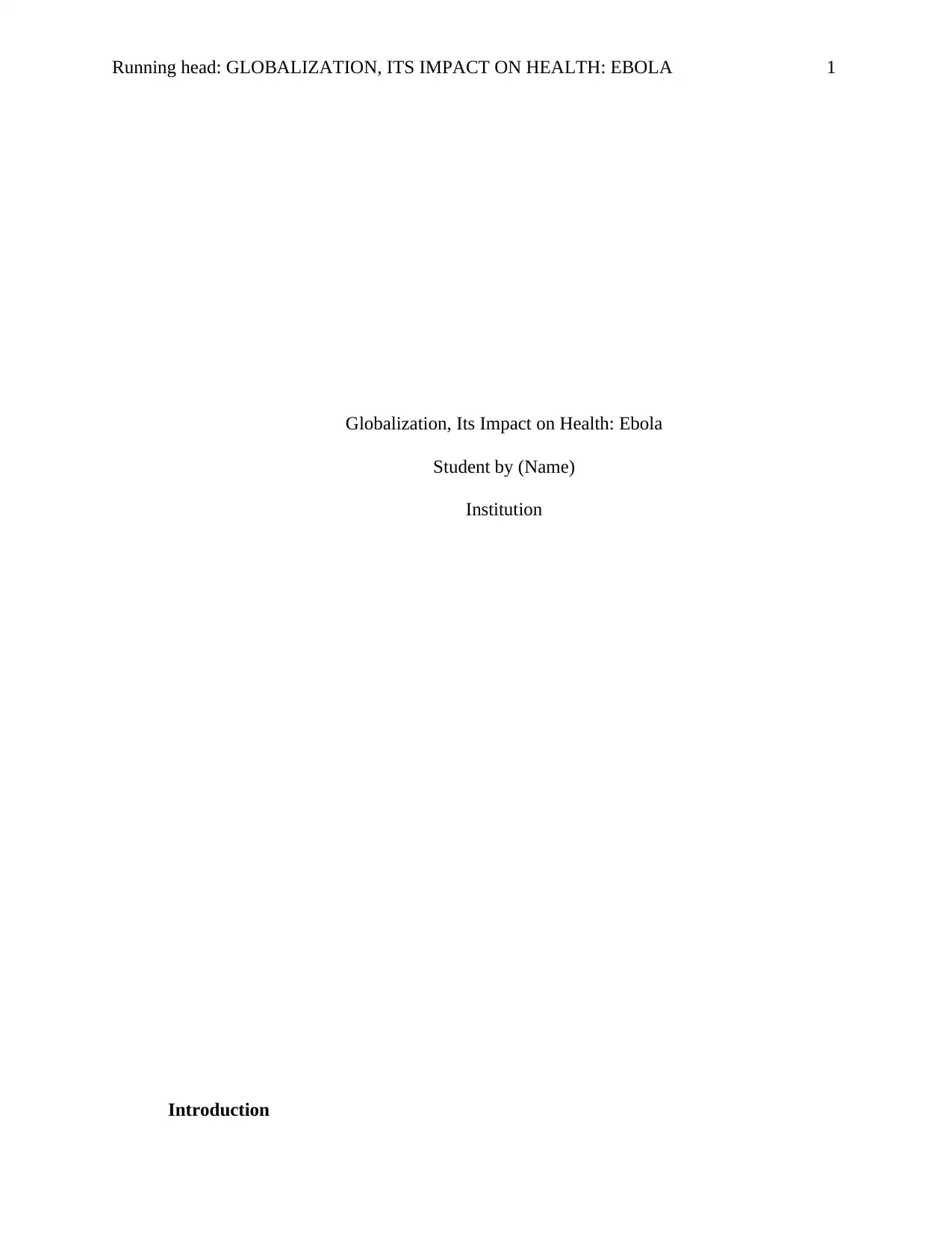
Running head: GLOBALIZATION, ITS IMPACT ON HEALTH: EBOLA 1
Globalization, Its Impact on Health: Ebola
Student by (Name)
Institution
Introduction
Globalization, Its Impact on Health: Ebola
Student by (Name)
Institution
Introduction
Paraphrase This Document
Need a fresh take? Get an instant paraphrase of this document with our AI Paraphraser
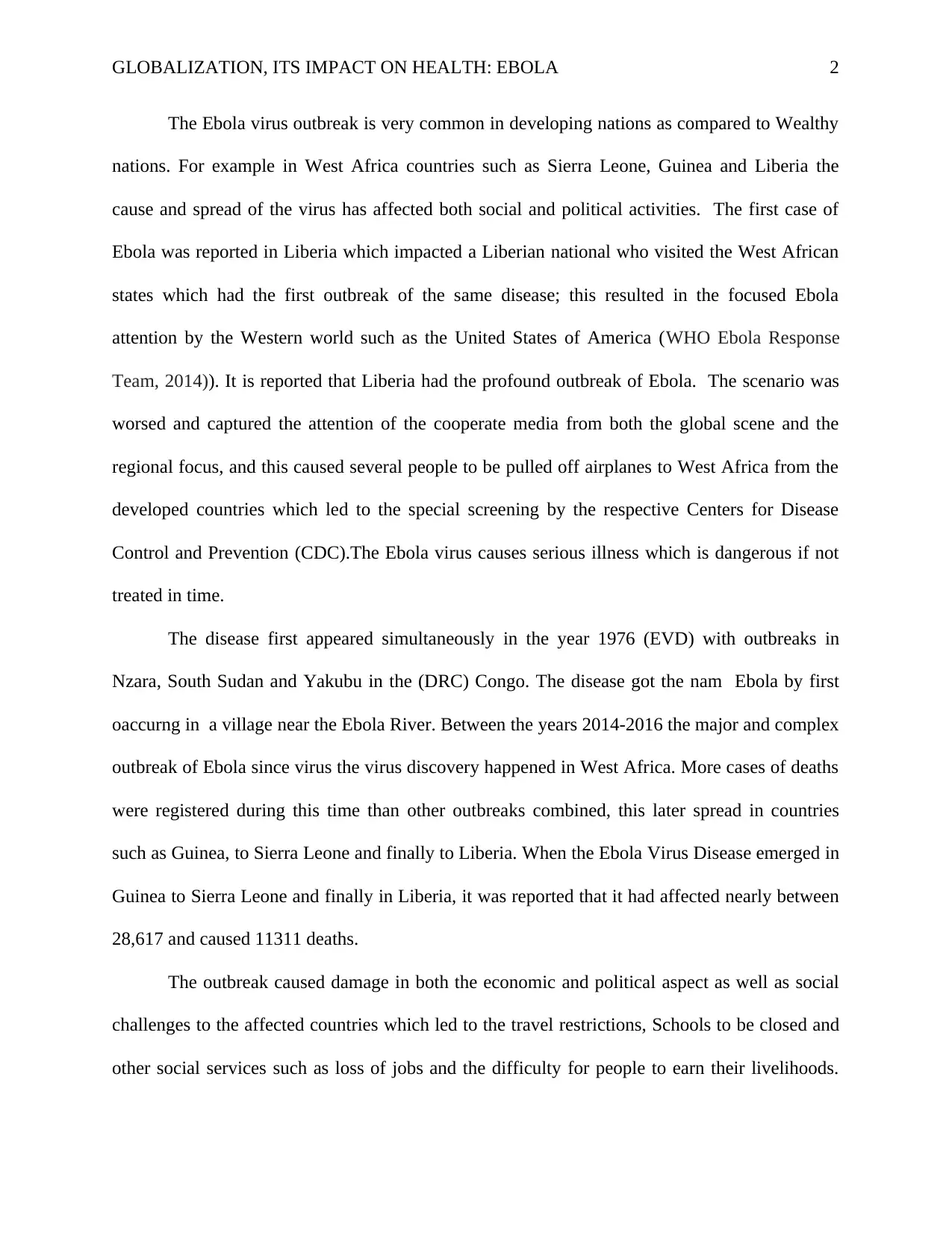
GLOBALIZATION, ITS IMPACT ON HEALTH: EBOLA 2
The Ebola virus outbreak is very common in developing nations as compared to Wealthy
nations. For example in West Africa countries such as Sierra Leone, Guinea and Liberia the
cause and spread of the virus has affected both social and political activities. The first case of
Ebola was reported in Liberia which impacted a Liberian national who visited the West African
states which had the first outbreak of the same disease; this resulted in the focused Ebola
attention by the Western world such as the United States of America (WHO Ebola Response
Team, 2014)). It is reported that Liberia had the profound outbreak of Ebola. The scenario was
worsed and captured the attention of the cooperate media from both the global scene and the
regional focus, and this caused several people to be pulled off airplanes to West Africa from the
developed countries which led to the special screening by the respective Centers for Disease
Control and Prevention (CDC).The Ebola virus causes serious illness which is dangerous if not
treated in time.
The disease first appeared simultaneously in the year 1976 (EVD) with outbreaks in
Nzara, South Sudan and Yakubu in the (DRC) Congo. The disease got the nam Ebola by first
oaccurng in a village near the Ebola River. Between the years 2014-2016 the major and complex
outbreak of Ebola since virus the virus discovery happened in West Africa. More cases of deaths
were registered during this time than other outbreaks combined, this later spread in countries
such as Guinea, to Sierra Leone and finally to Liberia. When the Ebola Virus Disease emerged in
Guinea to Sierra Leone and finally in Liberia, it was reported that it had affected nearly between
28,617 and caused 11311 deaths.
The outbreak caused damage in both the economic and political aspect as well as social
challenges to the affected countries which led to the travel restrictions, Schools to be closed and
other social services such as loss of jobs and the difficulty for people to earn their livelihoods.
The Ebola virus outbreak is very common in developing nations as compared to Wealthy
nations. For example in West Africa countries such as Sierra Leone, Guinea and Liberia the
cause and spread of the virus has affected both social and political activities. The first case of
Ebola was reported in Liberia which impacted a Liberian national who visited the West African
states which had the first outbreak of the same disease; this resulted in the focused Ebola
attention by the Western world such as the United States of America (WHO Ebola Response
Team, 2014)). It is reported that Liberia had the profound outbreak of Ebola. The scenario was
worsed and captured the attention of the cooperate media from both the global scene and the
regional focus, and this caused several people to be pulled off airplanes to West Africa from the
developed countries which led to the special screening by the respective Centers for Disease
Control and Prevention (CDC).The Ebola virus causes serious illness which is dangerous if not
treated in time.
The disease first appeared simultaneously in the year 1976 (EVD) with outbreaks in
Nzara, South Sudan and Yakubu in the (DRC) Congo. The disease got the nam Ebola by first
oaccurng in a village near the Ebola River. Between the years 2014-2016 the major and complex
outbreak of Ebola since virus the virus discovery happened in West Africa. More cases of deaths
were registered during this time than other outbreaks combined, this later spread in countries
such as Guinea, to Sierra Leone and finally to Liberia. When the Ebola Virus Disease emerged in
Guinea to Sierra Leone and finally in Liberia, it was reported that it had affected nearly between
28,617 and caused 11311 deaths.
The outbreak caused damage in both the economic and political aspect as well as social
challenges to the affected countries which led to the travel restrictions, Schools to be closed and
other social services such as loss of jobs and the difficulty for people to earn their livelihoods.
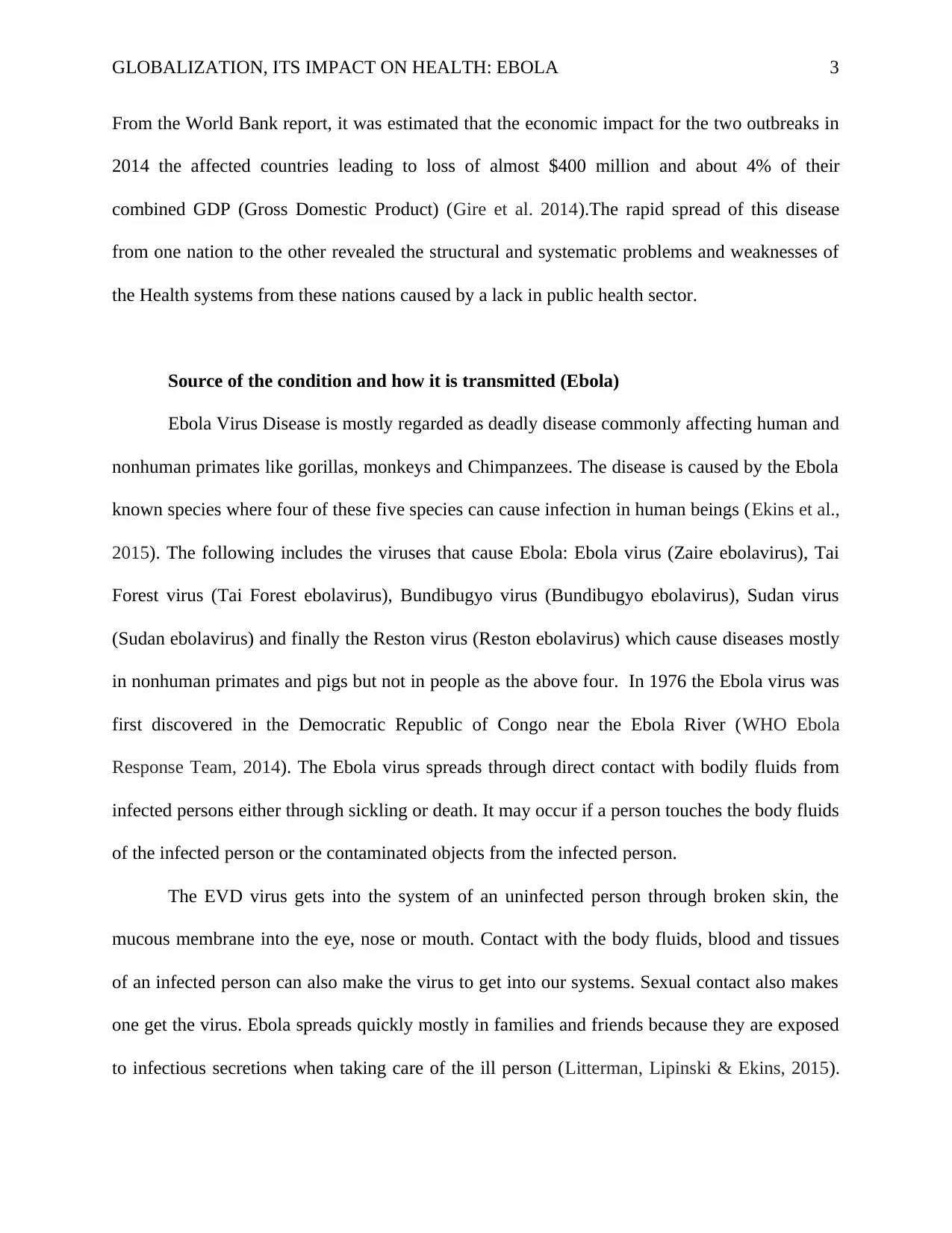
GLOBALIZATION, ITS IMPACT ON HEALTH: EBOLA 3
From the World Bank report, it was estimated that the economic impact for the two outbreaks in
2014 the affected countries leading to loss of almost $400 million and about 4% of their
combined GDP (Gross Domestic Product) (Gire et al. 2014).The rapid spread of this disease
from one nation to the other revealed the structural and systematic problems and weaknesses of
the Health systems from these nations caused by a lack in public health sector.
Source of the condition and how it is transmitted (Ebola)
Ebola Virus Disease is mostly regarded as deadly disease commonly affecting human and
nonhuman primates like gorillas, monkeys and Chimpanzees. The disease is caused by the Ebola
known species where four of these five species can cause infection in human beings (Ekins et al.,
2015). The following includes the viruses that cause Ebola: Ebola virus (Zaire ebolavirus), Tai
Forest virus (Tai Forest ebolavirus), Bundibugyo virus (Bundibugyo ebolavirus), Sudan virus
(Sudan ebolavirus) and finally the Reston virus (Reston ebolavirus) which cause diseases mostly
in nonhuman primates and pigs but not in people as the above four. In 1976 the Ebola virus was
first discovered in the Democratic Republic of Congo near the Ebola River (WHO Ebola
Response Team, 2014). The Ebola virus spreads through direct contact with bodily fluids from
infected persons either through sickling or death. It may occur if a person touches the body fluids
of the infected person or the contaminated objects from the infected person.
The EVD virus gets into the system of an uninfected person through broken skin, the
mucous membrane into the eye, nose or mouth. Contact with the body fluids, blood and tissues
of an infected person can also make the virus to get into our systems. Sexual contact also makes
one get the virus. Ebola spreads quickly mostly in families and friends because they are exposed
to infectious secretions when taking care of the ill person (Litterman, Lipinski & Ekins, 2015).
From the World Bank report, it was estimated that the economic impact for the two outbreaks in
2014 the affected countries leading to loss of almost $400 million and about 4% of their
combined GDP (Gross Domestic Product) (Gire et al. 2014).The rapid spread of this disease
from one nation to the other revealed the structural and systematic problems and weaknesses of
the Health systems from these nations caused by a lack in public health sector.
Source of the condition and how it is transmitted (Ebola)
Ebola Virus Disease is mostly regarded as deadly disease commonly affecting human and
nonhuman primates like gorillas, monkeys and Chimpanzees. The disease is caused by the Ebola
known species where four of these five species can cause infection in human beings (Ekins et al.,
2015). The following includes the viruses that cause Ebola: Ebola virus (Zaire ebolavirus), Tai
Forest virus (Tai Forest ebolavirus), Bundibugyo virus (Bundibugyo ebolavirus), Sudan virus
(Sudan ebolavirus) and finally the Reston virus (Reston ebolavirus) which cause diseases mostly
in nonhuman primates and pigs but not in people as the above four. In 1976 the Ebola virus was
first discovered in the Democratic Republic of Congo near the Ebola River (WHO Ebola
Response Team, 2014). The Ebola virus spreads through direct contact with bodily fluids from
infected persons either through sickling or death. It may occur if a person touches the body fluids
of the infected person or the contaminated objects from the infected person.
The EVD virus gets into the system of an uninfected person through broken skin, the
mucous membrane into the eye, nose or mouth. Contact with the body fluids, blood and tissues
of an infected person can also make the virus to get into our systems. Sexual contact also makes
one get the virus. Ebola spreads quickly mostly in families and friends because they are exposed
to infectious secretions when taking care of the ill person (Litterman, Lipinski & Ekins, 2015).
⊘ This is a preview!⊘
Do you want full access?
Subscribe today to unlock all pages.

Trusted by 1+ million students worldwide
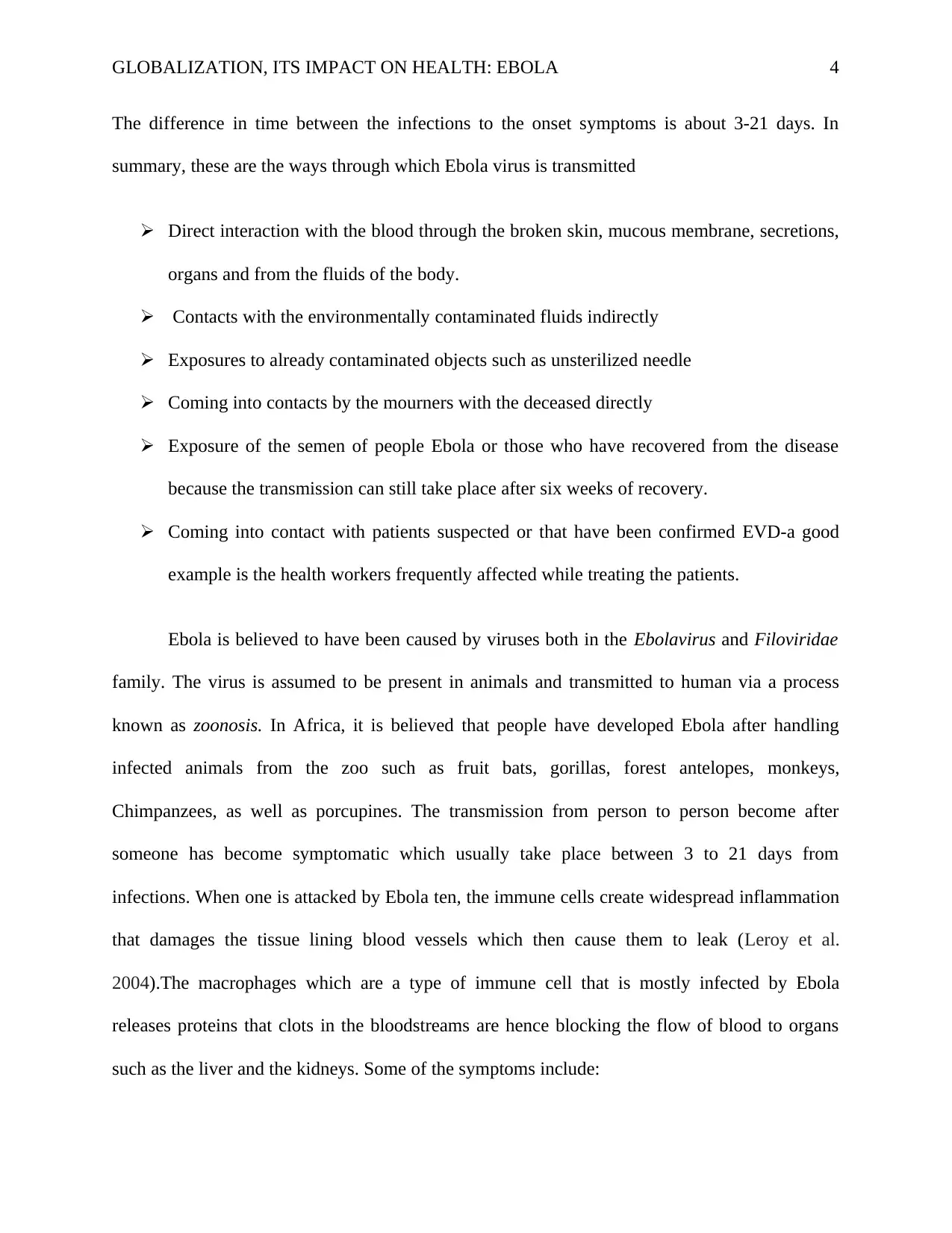
GLOBALIZATION, ITS IMPACT ON HEALTH: EBOLA 4
The difference in time between the infections to the onset symptoms is about 3-21 days. In
summary, these are the ways through which Ebola virus is transmitted
Direct interaction with the blood through the broken skin, mucous membrane, secretions,
organs and from the fluids of the body.
Contacts with the environmentally contaminated fluids indirectly
Exposures to already contaminated objects such as unsterilized needle
Coming into contacts by the mourners with the deceased directly
Exposure of the semen of people Ebola or those who have recovered from the disease
because the transmission can still take place after six weeks of recovery.
Coming into contact with patients suspected or that have been confirmed EVD-a good
example is the health workers frequently affected while treating the patients.
Ebola is believed to have been caused by viruses both in the Ebolavirus and Filoviridae
family. The virus is assumed to be present in animals and transmitted to human via a process
known as zoonosis. In Africa, it is believed that people have developed Ebola after handling
infected animals from the zoo such as fruit bats, gorillas, forest antelopes, monkeys,
Chimpanzees, as well as porcupines. The transmission from person to person become after
someone has become symptomatic which usually take place between 3 to 21 days from
infections. When one is attacked by Ebola ten, the immune cells create widespread inflammation
that damages the tissue lining blood vessels which then cause them to leak (Leroy et al.
2004).The macrophages which are a type of immune cell that is mostly infected by Ebola
releases proteins that clots in the bloodstreams are hence blocking the flow of blood to organs
such as the liver and the kidneys. Some of the symptoms include:
The difference in time between the infections to the onset symptoms is about 3-21 days. In
summary, these are the ways through which Ebola virus is transmitted
Direct interaction with the blood through the broken skin, mucous membrane, secretions,
organs and from the fluids of the body.
Contacts with the environmentally contaminated fluids indirectly
Exposures to already contaminated objects such as unsterilized needle
Coming into contacts by the mourners with the deceased directly
Exposure of the semen of people Ebola or those who have recovered from the disease
because the transmission can still take place after six weeks of recovery.
Coming into contact with patients suspected or that have been confirmed EVD-a good
example is the health workers frequently affected while treating the patients.
Ebola is believed to have been caused by viruses both in the Ebolavirus and Filoviridae
family. The virus is assumed to be present in animals and transmitted to human via a process
known as zoonosis. In Africa, it is believed that people have developed Ebola after handling
infected animals from the zoo such as fruit bats, gorillas, forest antelopes, monkeys,
Chimpanzees, as well as porcupines. The transmission from person to person become after
someone has become symptomatic which usually take place between 3 to 21 days from
infections. When one is attacked by Ebola ten, the immune cells create widespread inflammation
that damages the tissue lining blood vessels which then cause them to leak (Leroy et al.
2004).The macrophages which are a type of immune cell that is mostly infected by Ebola
releases proteins that clots in the bloodstreams are hence blocking the flow of blood to organs
such as the liver and the kidneys. Some of the symptoms include:
Paraphrase This Document
Need a fresh take? Get an instant paraphrase of this document with our AI Paraphraser
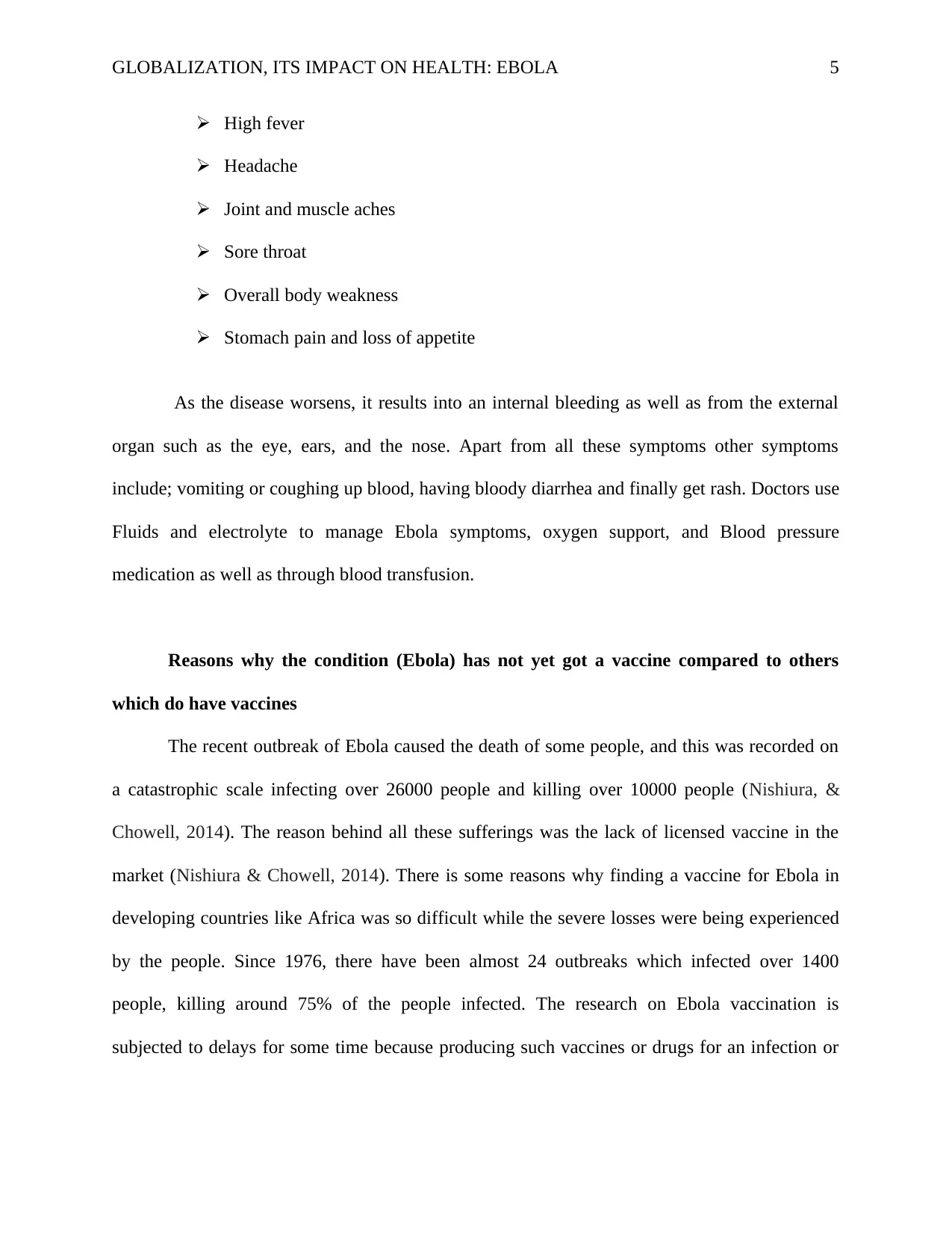
GLOBALIZATION, ITS IMPACT ON HEALTH: EBOLA 5
High fever
Headache
Joint and muscle aches
Sore throat
Overall body weakness
Stomach pain and loss of appetite
As the disease worsens, it results into an internal bleeding as well as from the external
organ such as the eye, ears, and the nose. Apart from all these symptoms other symptoms
include; vomiting or coughing up blood, having bloody diarrhea and finally get rash. Doctors use
Fluids and electrolyte to manage Ebola symptoms, oxygen support, and Blood pressure
medication as well as through blood transfusion.
Reasons why the condition (Ebola) has not yet got a vaccine compared to others
which do have vaccines
The recent outbreak of Ebola caused the death of some people, and this was recorded on
a catastrophic scale infecting over 26000 people and killing over 10000 people (Nishiura, &
Chowell, 2014). The reason behind all these sufferings was the lack of licensed vaccine in the
market (Nishiura & Chowell, 2014). There is some reasons why finding a vaccine for Ebola in
developing countries like Africa was so difficult while the severe losses were being experienced
by the people. Since 1976, there have been almost 24 outbreaks which infected over 1400
people, killing around 75% of the people infected. The research on Ebola vaccination is
subjected to delays for some time because producing such vaccines or drugs for an infection or
High fever
Headache
Joint and muscle aches
Sore throat
Overall body weakness
Stomach pain and loss of appetite
As the disease worsens, it results into an internal bleeding as well as from the external
organ such as the eye, ears, and the nose. Apart from all these symptoms other symptoms
include; vomiting or coughing up blood, having bloody diarrhea and finally get rash. Doctors use
Fluids and electrolyte to manage Ebola symptoms, oxygen support, and Blood pressure
medication as well as through blood transfusion.
Reasons why the condition (Ebola) has not yet got a vaccine compared to others
which do have vaccines
The recent outbreak of Ebola caused the death of some people, and this was recorded on
a catastrophic scale infecting over 26000 people and killing over 10000 people (Nishiura, &
Chowell, 2014). The reason behind all these sufferings was the lack of licensed vaccine in the
market (Nishiura & Chowell, 2014). There is some reasons why finding a vaccine for Ebola in
developing countries like Africa was so difficult while the severe losses were being experienced
by the people. Since 1976, there have been almost 24 outbreaks which infected over 1400
people, killing around 75% of the people infected. The research on Ebola vaccination is
subjected to delays for some time because producing such vaccines or drugs for an infection or
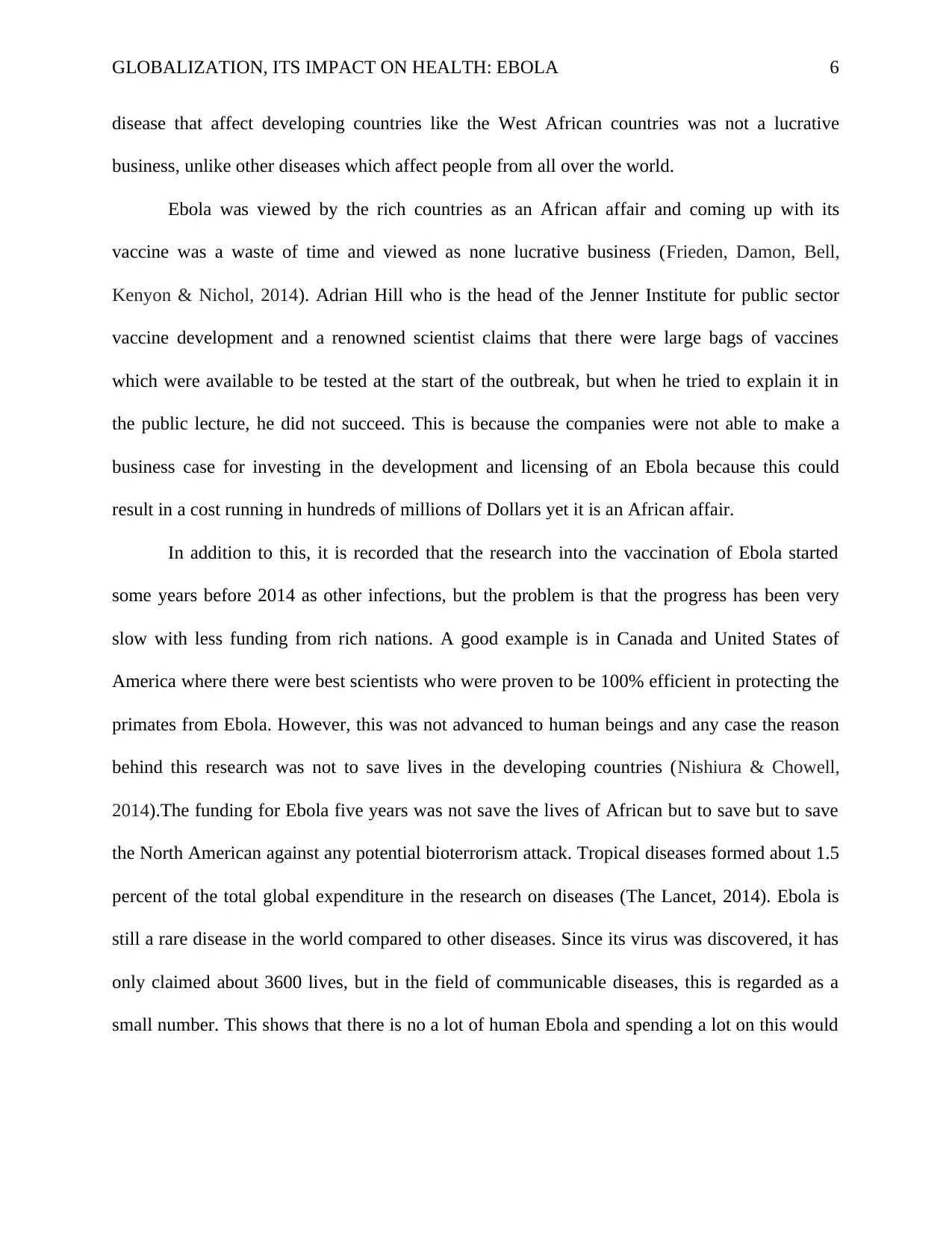
GLOBALIZATION, ITS IMPACT ON HEALTH: EBOLA 6
disease that affect developing countries like the West African countries was not a lucrative
business, unlike other diseases which affect people from all over the world.
Ebola was viewed by the rich countries as an African affair and coming up with its
vaccine was a waste of time and viewed as none lucrative business (Frieden, Damon, Bell,
Kenyon & Nichol, 2014). Adrian Hill who is the head of the Jenner Institute for public sector
vaccine development and a renowned scientist claims that there were large bags of vaccines
which were available to be tested at the start of the outbreak, but when he tried to explain it in
the public lecture, he did not succeed. This is because the companies were not able to make a
business case for investing in the development and licensing of an Ebola because this could
result in a cost running in hundreds of millions of Dollars yet it is an African affair.
In addition to this, it is recorded that the research into the vaccination of Ebola started
some years before 2014 as other infections, but the problem is that the progress has been very
slow with less funding from rich nations. A good example is in Canada and United States of
America where there were best scientists who were proven to be 100% efficient in protecting the
primates from Ebola. However, this was not advanced to human beings and any case the reason
behind this research was not to save lives in the developing countries (Nishiura & Chowell,
2014).The funding for Ebola five years was not save the lives of African but to save but to save
the North American against any potential bioterrorism attack. Tropical diseases formed about 1.5
percent of the total global expenditure in the research on diseases (The Lancet, 2014). Ebola is
still a rare disease in the world compared to other diseases. Since its virus was discovered, it has
only claimed about 3600 lives, but in the field of communicable diseases, this is regarded as a
small number. This shows that there is no a lot of human Ebola and spending a lot on this would
disease that affect developing countries like the West African countries was not a lucrative
business, unlike other diseases which affect people from all over the world.
Ebola was viewed by the rich countries as an African affair and coming up with its
vaccine was a waste of time and viewed as none lucrative business (Frieden, Damon, Bell,
Kenyon & Nichol, 2014). Adrian Hill who is the head of the Jenner Institute for public sector
vaccine development and a renowned scientist claims that there were large bags of vaccines
which were available to be tested at the start of the outbreak, but when he tried to explain it in
the public lecture, he did not succeed. This is because the companies were not able to make a
business case for investing in the development and licensing of an Ebola because this could
result in a cost running in hundreds of millions of Dollars yet it is an African affair.
In addition to this, it is recorded that the research into the vaccination of Ebola started
some years before 2014 as other infections, but the problem is that the progress has been very
slow with less funding from rich nations. A good example is in Canada and United States of
America where there were best scientists who were proven to be 100% efficient in protecting the
primates from Ebola. However, this was not advanced to human beings and any case the reason
behind this research was not to save lives in the developing countries (Nishiura & Chowell,
2014).The funding for Ebola five years was not save the lives of African but to save but to save
the North American against any potential bioterrorism attack. Tropical diseases formed about 1.5
percent of the total global expenditure in the research on diseases (The Lancet, 2014). Ebola is
still a rare disease in the world compared to other diseases. Since its virus was discovered, it has
only claimed about 3600 lives, but in the field of communicable diseases, this is regarded as a
small number. This shows that there is no a lot of human Ebola and spending a lot on this would
⊘ This is a preview!⊘
Do you want full access?
Subscribe today to unlock all pages.

Trusted by 1+ million students worldwide
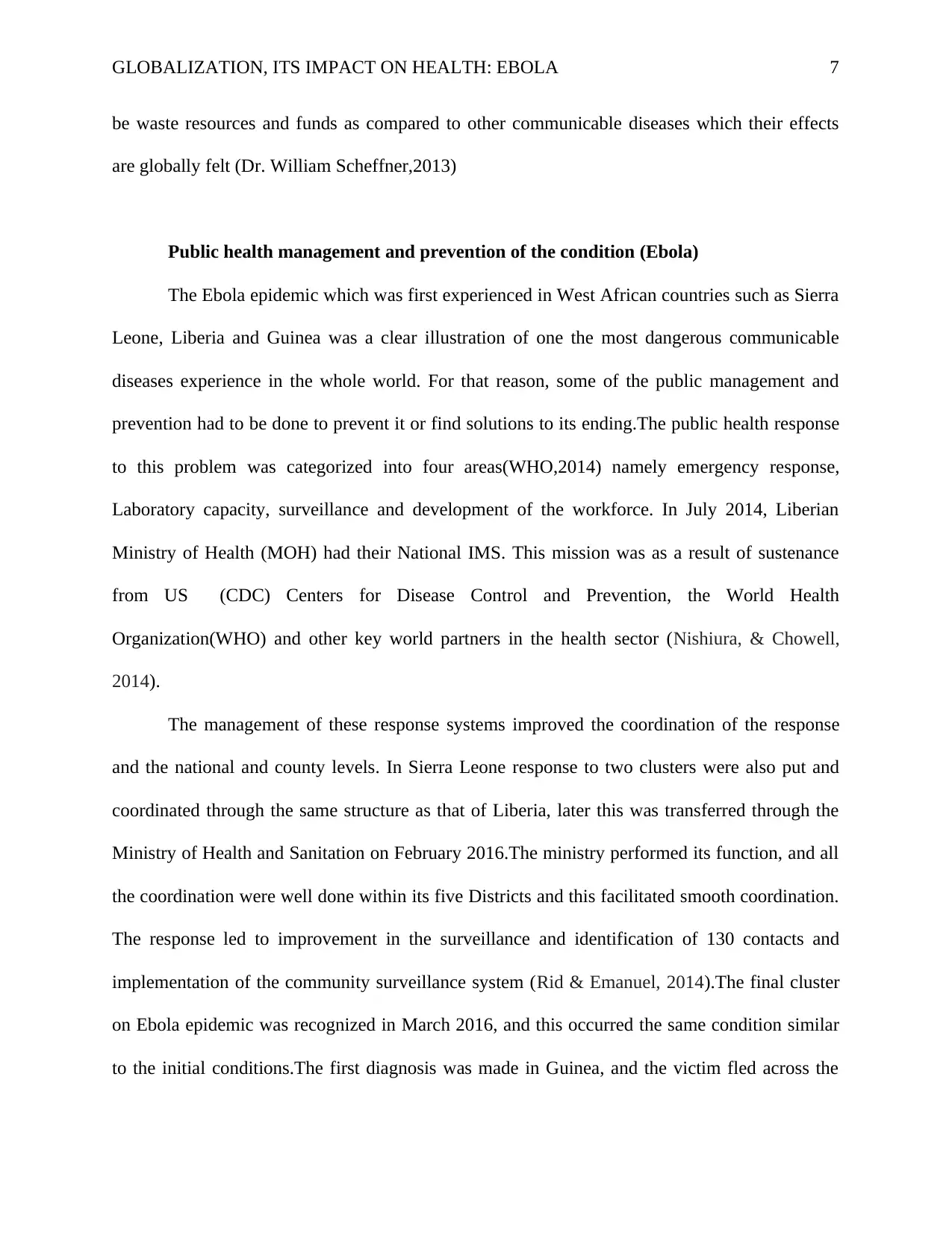
GLOBALIZATION, ITS IMPACT ON HEALTH: EBOLA 7
be waste resources and funds as compared to other communicable diseases which their effects
are globally felt (Dr. William Scheffner,2013)
Public health management and prevention of the condition (Ebola)
The Ebola epidemic which was first experienced in West African countries such as Sierra
Leone, Liberia and Guinea was a clear illustration of one the most dangerous communicable
diseases experience in the whole world. For that reason, some of the public management and
prevention had to be done to prevent it or find solutions to its ending.The public health response
to this problem was categorized into four areas(WHO,2014) namely emergency response,
Laboratory capacity, surveillance and development of the workforce. In July 2014, Liberian
Ministry of Health (MOH) had their National IMS. This mission was as a result of sustenance
from US (CDC) Centers for Disease Control and Prevention, the World Health
Organization(WHO) and other key world partners in the health sector (Nishiura, & Chowell,
2014).
The management of these response systems improved the coordination of the response
and the national and county levels. In Sierra Leone response to two clusters were also put and
coordinated through the same structure as that of Liberia, later this was transferred through the
Ministry of Health and Sanitation on February 2016.The ministry performed its function, and all
the coordination were well done within its five Districts and this facilitated smooth coordination.
The response led to improvement in the surveillance and identification of 130 contacts and
implementation of the community surveillance system (Rid & Emanuel, 2014).The final cluster
on Ebola epidemic was recognized in March 2016, and this occurred the same condition similar
to the initial conditions.The first diagnosis was made in Guinea, and the victim fled across the
be waste resources and funds as compared to other communicable diseases which their effects
are globally felt (Dr. William Scheffner,2013)
Public health management and prevention of the condition (Ebola)
The Ebola epidemic which was first experienced in West African countries such as Sierra
Leone, Liberia and Guinea was a clear illustration of one the most dangerous communicable
diseases experience in the whole world. For that reason, some of the public management and
prevention had to be done to prevent it or find solutions to its ending.The public health response
to this problem was categorized into four areas(WHO,2014) namely emergency response,
Laboratory capacity, surveillance and development of the workforce. In July 2014, Liberian
Ministry of Health (MOH) had their National IMS. This mission was as a result of sustenance
from US (CDC) Centers for Disease Control and Prevention, the World Health
Organization(WHO) and other key world partners in the health sector (Nishiura, & Chowell,
2014).
The management of these response systems improved the coordination of the response
and the national and county levels. In Sierra Leone response to two clusters were also put and
coordinated through the same structure as that of Liberia, later this was transferred through the
Ministry of Health and Sanitation on February 2016.The ministry performed its function, and all
the coordination were well done within its five Districts and this facilitated smooth coordination.
The response led to improvement in the surveillance and identification of 130 contacts and
implementation of the community surveillance system (Rid & Emanuel, 2014).The final cluster
on Ebola epidemic was recognized in March 2016, and this occurred the same condition similar
to the initial conditions.The first diagnosis was made in Guinea, and the victim fled across the
Paraphrase This Document
Need a fresh take? Get an instant paraphrase of this document with our AI Paraphraser
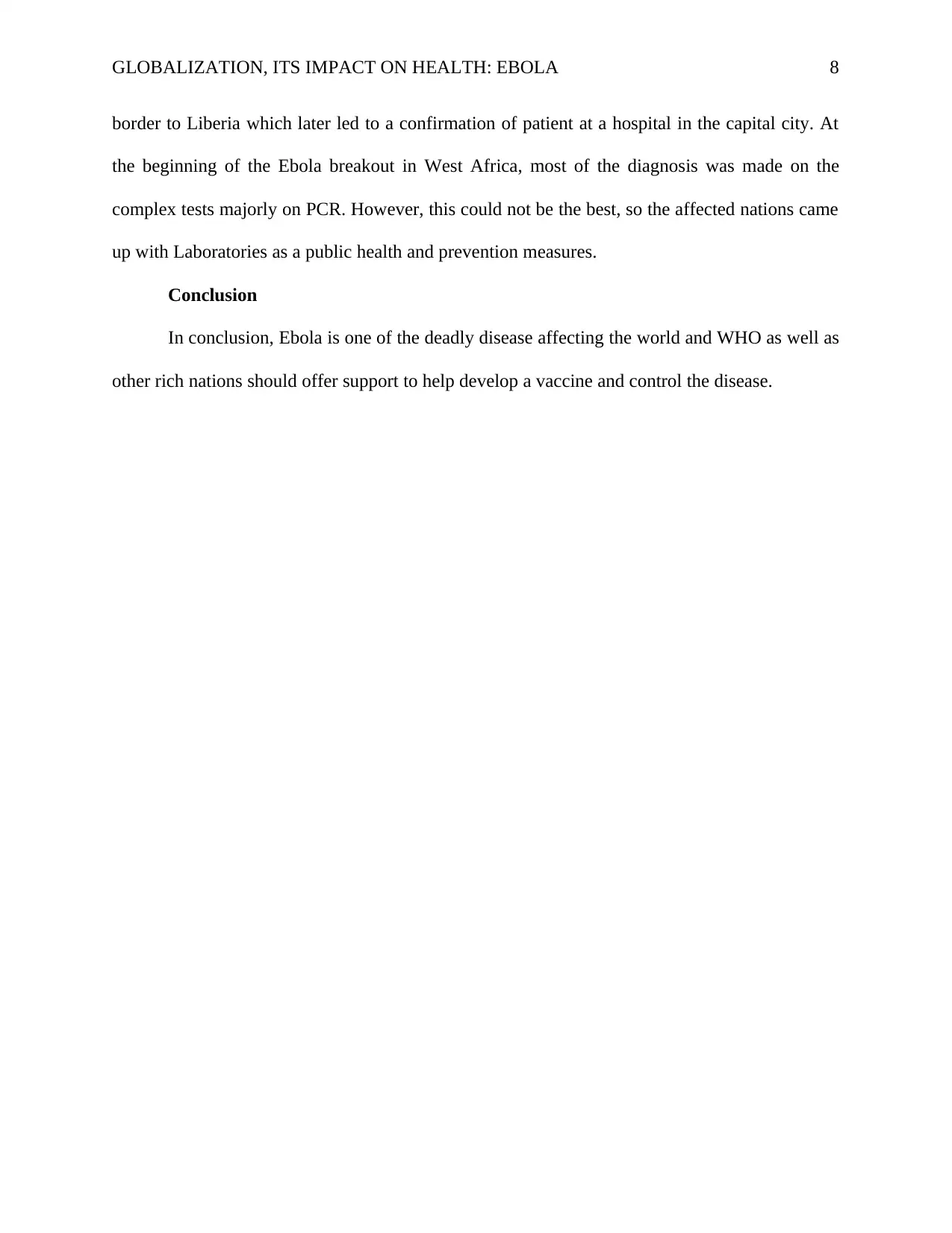
GLOBALIZATION, ITS IMPACT ON HEALTH: EBOLA 8
border to Liberia which later led to a confirmation of patient at a hospital in the capital city. At
the beginning of the Ebola breakout in West Africa, most of the diagnosis was made on the
complex tests majorly on PCR. However, this could not be the best, so the affected nations came
up with Laboratories as a public health and prevention measures.
Conclusion
In conclusion, Ebola is one of the deadly disease affecting the world and WHO as well as
other rich nations should offer support to help develop a vaccine and control the disease.
border to Liberia which later led to a confirmation of patient at a hospital in the capital city. At
the beginning of the Ebola breakout in West Africa, most of the diagnosis was made on the
complex tests majorly on PCR. However, this could not be the best, so the affected nations came
up with Laboratories as a public health and prevention measures.
Conclusion
In conclusion, Ebola is one of the deadly disease affecting the world and WHO as well as
other rich nations should offer support to help develop a vaccine and control the disease.
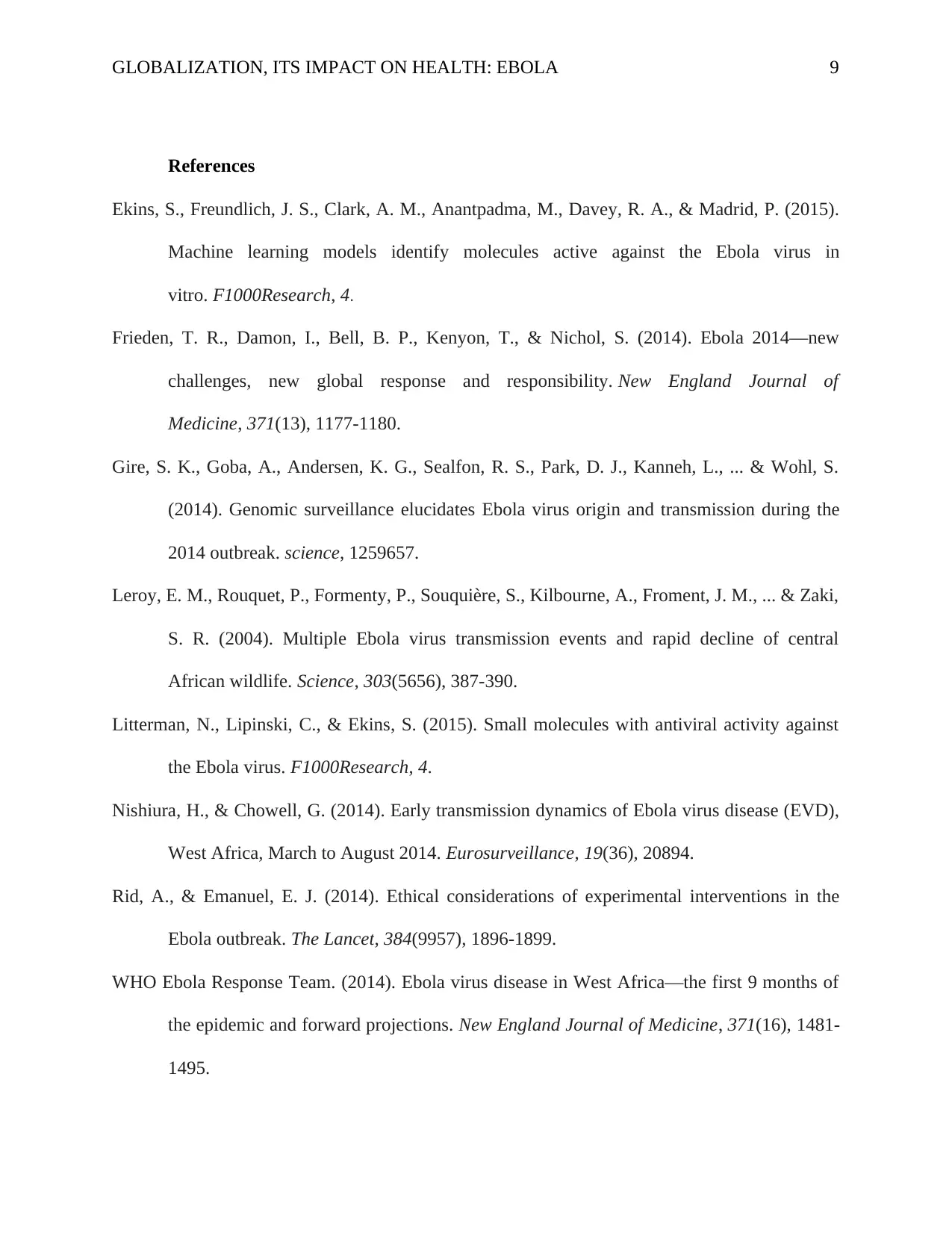
GLOBALIZATION, ITS IMPACT ON HEALTH: EBOLA 9
References
Ekins, S., Freundlich, J. S., Clark, A. M., Anantpadma, M., Davey, R. A., & Madrid, P. (2015).
Machine learning models identify molecules active against the Ebola virus in
vitro. F1000Research, 4.
Frieden, T. R., Damon, I., Bell, B. P., Kenyon, T., & Nichol, S. (2014). Ebola 2014—new
challenges, new global response and responsibility. New England Journal of
Medicine, 371(13), 1177-1180.
Gire, S. K., Goba, A., Andersen, K. G., Sealfon, R. S., Park, D. J., Kanneh, L., ... & Wohl, S.
(2014). Genomic surveillance elucidates Ebola virus origin and transmission during the
2014 outbreak. science, 1259657.
Leroy, E. M., Rouquet, P., Formenty, P., Souquière, S., Kilbourne, A., Froment, J. M., ... & Zaki,
S. R. (2004). Multiple Ebola virus transmission events and rapid decline of central
African wildlife. Science, 303(5656), 387-390.
Litterman, N., Lipinski, C., & Ekins, S. (2015). Small molecules with antiviral activity against
the Ebola virus. F1000Research, 4.
Nishiura, H., & Chowell, G. (2014). Early transmission dynamics of Ebola virus disease (EVD),
West Africa, March to August 2014. Eurosurveillance, 19(36), 20894.
Rid, A., & Emanuel, E. J. (2014). Ethical considerations of experimental interventions in the
Ebola outbreak. The Lancet, 384(9957), 1896-1899.
WHO Ebola Response Team. (2014). Ebola virus disease in West Africa—the first 9 months of
the epidemic and forward projections. New England Journal of Medicine, 371(16), 1481-
1495.
References
Ekins, S., Freundlich, J. S., Clark, A. M., Anantpadma, M., Davey, R. A., & Madrid, P. (2015).
Machine learning models identify molecules active against the Ebola virus in
vitro. F1000Research, 4.
Frieden, T. R., Damon, I., Bell, B. P., Kenyon, T., & Nichol, S. (2014). Ebola 2014—new
challenges, new global response and responsibility. New England Journal of
Medicine, 371(13), 1177-1180.
Gire, S. K., Goba, A., Andersen, K. G., Sealfon, R. S., Park, D. J., Kanneh, L., ... & Wohl, S.
(2014). Genomic surveillance elucidates Ebola virus origin and transmission during the
2014 outbreak. science, 1259657.
Leroy, E. M., Rouquet, P., Formenty, P., Souquière, S., Kilbourne, A., Froment, J. M., ... & Zaki,
S. R. (2004). Multiple Ebola virus transmission events and rapid decline of central
African wildlife. Science, 303(5656), 387-390.
Litterman, N., Lipinski, C., & Ekins, S. (2015). Small molecules with antiviral activity against
the Ebola virus. F1000Research, 4.
Nishiura, H., & Chowell, G. (2014). Early transmission dynamics of Ebola virus disease (EVD),
West Africa, March to August 2014. Eurosurveillance, 19(36), 20894.
Rid, A., & Emanuel, E. J. (2014). Ethical considerations of experimental interventions in the
Ebola outbreak. The Lancet, 384(9957), 1896-1899.
WHO Ebola Response Team. (2014). Ebola virus disease in West Africa—the first 9 months of
the epidemic and forward projections. New England Journal of Medicine, 371(16), 1481-
1495.
⊘ This is a preview!⊘
Do you want full access?
Subscribe today to unlock all pages.

Trusted by 1+ million students worldwide

GLOBALIZATION, ITS IMPACT ON HEALTH: EBOLA
10
10
1 out of 10
Related Documents
Your All-in-One AI-Powered Toolkit for Academic Success.
+13062052269
info@desklib.com
Available 24*7 on WhatsApp / Email
![[object Object]](/_next/static/media/star-bottom.7253800d.svg)
Unlock your academic potential
Copyright © 2020–2025 A2Z Services. All Rights Reserved. Developed and managed by ZUCOL.





